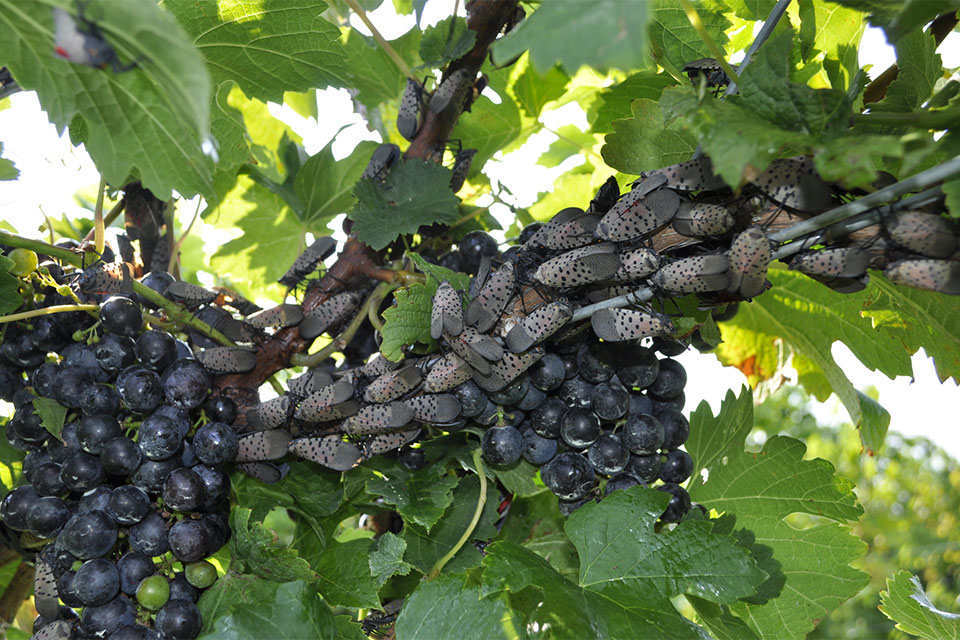Heads Up: The Spotted Lanternfly Is Coming
California growers, who have weathered the invasion of several invading insects in recent years, look like they will soon have another one to deal with, the spotted lanternfly.
Dr. Surendra Dara, University of California Cooperative Extension Advisor-Entomology and Biologicals, is trying to get the word out to growers that they should be prepared for the nasty pest.
“Know there is a potential threat and be aware of how to ID it,” says Dara, who has produced a video and webinar for growers. “Knowing about the pest is crucial to being prepared.”
The spotted lanternfly (Lycorma delicatula) arrived in Bucks County, PA, in 2014 and quickly became one of the top insect pests of concern there and in neighboring states. While its preferred host is tree-of-heaven (Ailanthus altissima), the spotted lanternfly has been reported to attack more than 70 plant species, including grapes, apples, cherries, and several other fruit and timber tree species.
Lycorma delicatula is not a fly but a kind of insect called a planthopper, and females lay eggs in masses on tree trunks, branches, rocks, or even walls or fences. The egg masses resemble clumps of mud, making them well suited to escaping detection and potentially hitching a ride to new locales on transported materials.
EYEWITNESS
One resident of Pennsylvania who can vouch for the insect’s destructiveness is Suzanne Wainwright-Evans, who attended the webinar. The owner of Buglady Consulting, she’s not an expert on spotted lanternfly but has had plenty of experience with it on her 7-acre farm.
“I have seen the trunk of a river birch tree covered solid (with insects),” she says, “and the surrounding lawn has turned black from sooty mold.”
While feeding, spotted lanternfly emits waste sugars that cover plant leaves and invite fungi to grow black sooty mold, a coating that inhibits the plants’ photosynthesis.
Experiences like that of Wainwright-Evans should be shared by growers because Dara believes enlisting the public’s support will be key to fighting the pest.
“Talk to your neighbors, as this is not just an issue for growers,” he says. “It’s the public I’d really like to educate, because the pest can come on vehicles and packages, and they’re the ones who might first identify it.”
Another concern for California is the abundance of tree-of-heaven, itself an exotic pest from China and spotted lanternfly’s favorite host. Tree-of-heaven — with roots, leaves, and bark used in traditional Chinese medicine — was brought to California by Chinese migrant workers during the Gold Rush. Its tendency to grow rapidly and multiply quickly has resulted in its designation as a noxious weed.
Tree-of-heaven offers a potential control strategy should spotted lanternfly come to California. Landowners can remove 85% of tree-of-heaven specimens in a grove, including all the female plants. The remaining 15% of tree-of-heaven will be irresistible to spotted lanternfly. The insects will congregate in the trees, which may be treated with systemic insecticides to kill the entire population.
BIOCONTROL PROMISING
Biocontrol is another important option. Dara notes that parasitoids have been found and are now being tested to make sure they are not only efficacious but also have no impact on nontarget species. For example, a parasitic wasp introduced into the U.S. in 1908 to control gypsy moths also appears to parasitize spotted lanternfly eggs. Research may permit the introduction of other harmless, natural spotted lanternfly enemies from the pest’s native range.
“Research is being done to manage the pest,” says Dara, “and by the time we get it in California — if we get it — we might have some good control options.”
It is important to note that California is not the only grape-rich state in the West that may be threatened. A habitat-modeling study last fall by USDA researchers showed that the grape-growing regions of Washington, a state second only to California in production, are at risk.

The spotted lanternfly’s range has been limited to the East Coast since being discovered in the U.S. in 2014, but climate models suggest it may only be a matter of time before it makes its way to the West Coast.
Research team leader Tewodros Wakie, an ARS Research Ecologist, says that despite being far removed from the spotted lanternfly’s current ranges, its ability to spread makes it a serious concern not only for Washington’s grape growers but also those of apples and cherries.
“The potential economic impact of newly arriving pests in Washington is huge,” Wakie says.










